On 4 March 2012 around 8 am the first of five explosions were heard in Brazzaville, the Republic of Congo. The blasts originated from a military ammunition storage facility in the area of Mpila near the neighbourhoods of Talangi and Oenze. The shock waves were felt across the city and debris struck buildings 4 kilometres away. The explosions were heard in neighbouring Kinshasha, capital of the Democratic Republic of Congo (DRC), across the river Congo.
The event resulted in the death of 250 people and the injured were in excess of 2 300. The hospitals were inundated. Injured patients were lying in the corridors. The majority were transported via taxis, military and police vehicles.
Due to the force of the explosion, it raised the military facility to the ground and destroyed all surrounding dwellings. It also caused several wide spread fires, leaving 13 800 people destitute. The refugees were relocated to the cathedral in the city centre and a covered market at Nkombo district in the North.
Upon investigation, munitions were found scattered all over the previously densely populated neighbourhoods surrounding the military facility. In the months following, explosive ordinance disposal (EOD) teams from the UN, EU, USA, France and Belgium worked on clearing area.
Brazzavile, Republic of Congo
The Republic of Congo gained its independence on 15 August 1960. In 1997, a six month long civil war broke out. President Denis Sassou-Nguesso has been in power ever since.
The Republic of Congo is located in central Africa, bordering the South Atlantic ocean. The country's neighbours are Democratic Republic of Congo (DRC), Angola and Gabon. It enjoys a tropical climate, with a rainy season lasting from March to October. During this time you will see sunny days turning black and spectacular thunder storms.
The country has a population of 4.3 million, of which 1.3 million reside in Brazzaville, the capital. A further million populates the coastal city of Pointe Noir. The city is multicultural, with a variety of expatriates making a living from its growing economy. French and Lingala are the main languages spoken.
The economy relies mainly on oil, with some exports of timber and sugar from the coastal port of Pointe Noire. All commodities are imported, mainly from China.
Health Issues
Like many sub-Saharan countries, Republic of Congo is crippled by human immunodeficiency virus (HIV), tuberculosis (TB), cholera, hepatitis A, typhoid and malaria. The general standard of health care is poor. The hospitals are ill-equipped and in disrepair. For the more affluent, there are privately run clinics in the major cities.
Common in many African countries, education is a real issue and Congo is not an exception. The medical staff received very archaic training, resulting in poor general practice. However, the majority of the doctors have worked or trained in Europe and other French speaking countries.
45% of the population is under 14 years old, with a median age of 17.1. The government spends 3% of its gross domestic product on healthcare and 1.9% on education. There is, however, a very high literacy rate.
With its booming economy, the cities suffers from air and water pollution, with the streets littered with plastic bottles, packaging, scrap metal, and general waste.
The greatest problem is the cost of medical care, and most of the hospitals don't have enough medication. Even in an emergency a patient's family would often be presented with a prescription to buy the relevant medication or equipment prior to treatment. These can be obtained from the multitude of pharmacies in the city. Everything costs money, so if you are poor you suffer.
Infrastructure
There is a very high presence of police and military in Brazzaville. A landmark building near the University Hospital is the fire brigade. It relies on an emergency number which is answered by a receptionist at the station to respond to all emergencies.
There isn't any emergency medical service (EMS) available in the country. You do see four-wheel drive ‘ambulances’ racing through the city, closely followed by green Toyota Hiace taxis loaded with people. After enquiring of their purpose, it turns out to be a funeral.
The government recently took delivery of 20 Toyota Land Cruisers that were converted into ambulances. These were manufactured in South Africa by Paramount (Pty) Ltd. They are similar to a military-styled field ambulance and ideal to navigate the potholes in the rainy season. As there is an abundance of Toyota vehicles in Africa, maintenance should not be a problem and the new fleet is equipped with stretchers and oxygen.
These vehicles are single operator and serve as a patient transfer vehicle. There are not any trained EMS staff in the country, but after the explosive event of 2012, this has become a ‘priority’. A year on and we are still waiting in anticipation.
The ambulances are located at various state-run hospitals in the capital. These hospitals serve each areas population and are generally very busy, unless it is raining. Then, by some mutual agreement, neither staff or patients tend to turn up.
Clinic
After the incident in 2012, a field hospital was flown in from South Africa by one of the gigantic Russian-built Ilyushin IL-76 aircraft.
It delivered six shipping containers to the Nkombo refugee camp. The fully equipped field hospital was donated by the Ichikowitz Family Foundation. The chairman of the foundation is South African entrepreneur Ivor Ichikowitz, chairman of Paramount (PTY) Ltd. A team of engineers were dispatched to assemble the hospital.
I was approached by the foundation in the week following the incident to fly out and help with the aftermath. Initially, we were only going to be there for three weeks to assist with whatever we could and to establish the hospital in the north of the city. After frantically updating all my vaccinations and my malaria medications, I left a very cold London and, via Paris, flew to Congo.
South African born, I had a fairly good idea what to expect, but after disembarking the heat soon took hold. The captain told us that it was 6:30 am and Brazzaville was enjoying a dry day, with a temperature of 30°C. What he forgot to mention was the humidity, and it was sweltering hot.
I was met by my operations director and several colleagues. It turned out they were South African intermediate life support (ILS) paramedics who had flown in the day before.
I was briefed on the current situation regarding the explosion the week before. Hitting the ground running was an under statement. Upon arrival at the hospital site, we were met by the South African engineers as they started to unload the shipping containers and begin construction.
Adjacent to the designated site were two large marques that looked like circus tents, but upon inspection, housed approximately 8 000 people (Figure 1). Waste and general hygiene were already a problem as there was no visible sanitation and no running water. Chickens and shy naked toddlers were running around cooking fires, shouting ‘Mundele, Mundele’ (Lingala word to describe a white person).
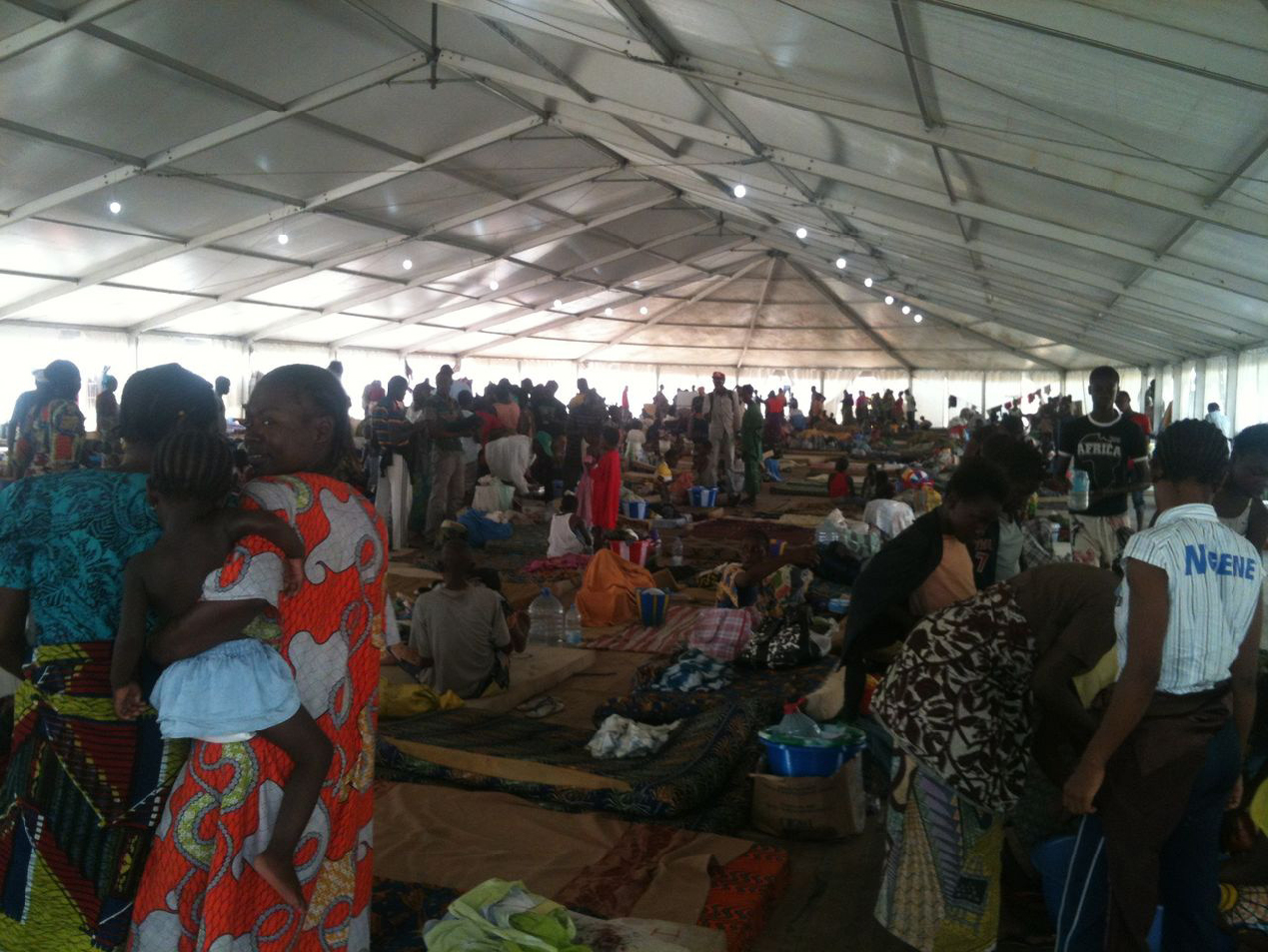
A singular old-style army tent, sponsored by the French petroleum company Total, was the only medical service on the site. The tent was manned by staff from Médecins d'Afrique, a French charity similar to the better known Doctors Without Borders. The running of the facility was left to a local doctor, as well as a staff from Médecins d'Afrique. The Congolese people struck me as a bit shy, but once greeted, very friendly and inquisitive. Violent crime is very low and the general population do not tolerate theft.
You could sense that there was a lot of tension in the air and a sense of desperation. Africa, in general, always has an undertone of tension, but this was elevated from the event a week prior.
It took us eight days and several late nights to build the hospital from the ground up. The maximum temperature recorded was 47°C and several days’ construction was halted due to spectacular thunderstorms followed by torrential rain.
The hospital consists of a central corridor and eight pods leading off it. The whole structure is elevated off the ground on metal posts. It is insulated inside and equipped with generators, air conditioning and running water supplied by a 20 000 gallon PVC water bladder (Figures 2–4).
Upon entering the main entrance there are two rooms either side. The larger one to the left acts as a general consultation room and the smaller one was assigned for obstetrics and gynaecology. The next two rooms facilitated the pharmacy and is also equipped with a fully functioning medical laboratory. This is followed by two smaller rooms which initially were used as counselling facilities before reverting to general treatment areas. At the rear of the hospital are separate male and female showers and toilet facilities.
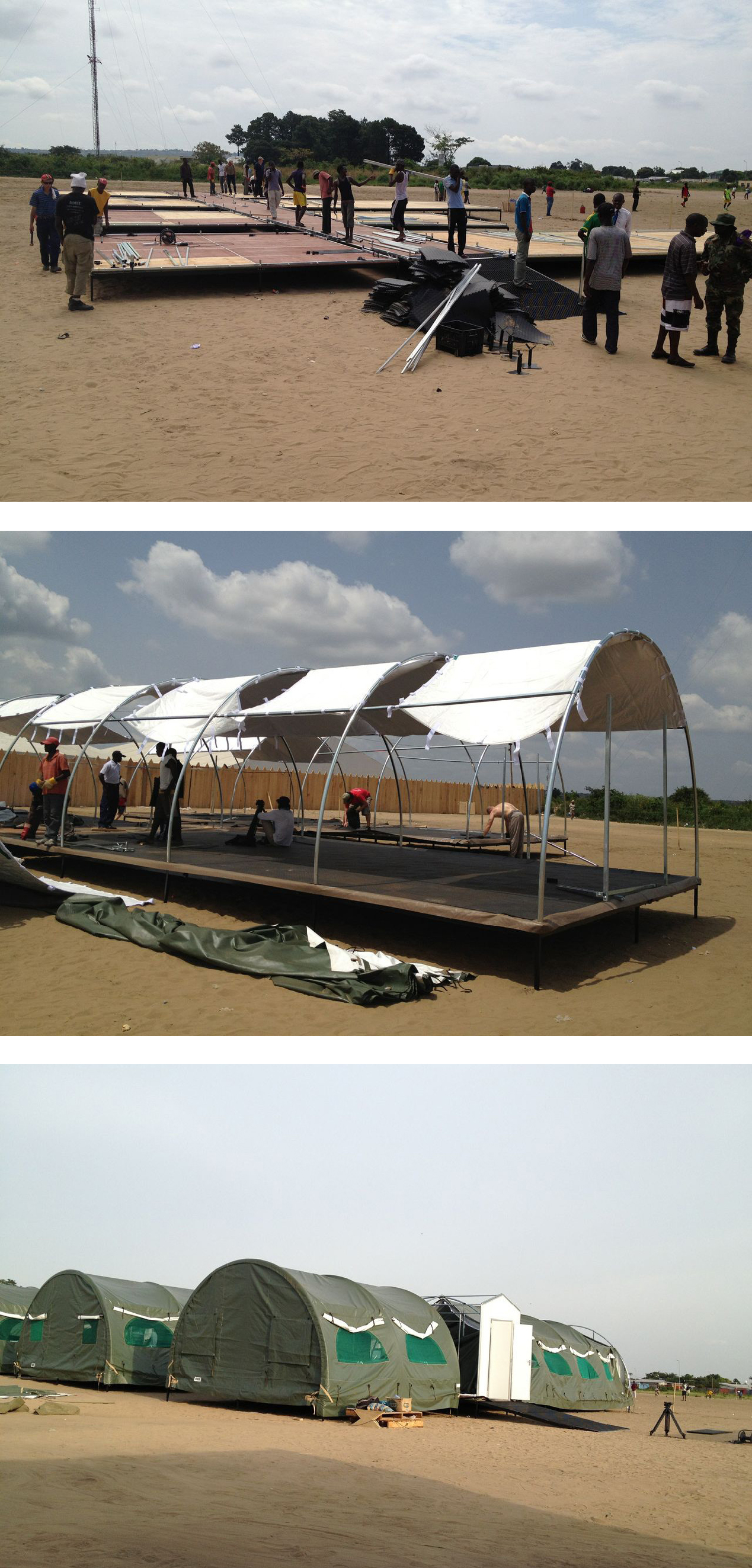
During this time the population of the refugee camp was growing. A four metre high wooden fence was built around the camp and hospital to keep some sort of control. The Red Cross and several other non-governmental organisations (NGOs) were now actively involved, supplying clean water and food aid to the people.
A week after arrival we were joined by two advanced life support paramedics, Scott Anderson (UK) and Koglien Moodley (RSA). They joined me for the last two weeks of what was our designated time to bring the hospital to operational level.
By this time my Doxycycline was making me photophobic and the slightest exposure to sunshine would turn me bright pink in colour. I decided to stop taking the malaria medication as the side effects were unbearable, and vastly outweighed the risk of contracting malaria.
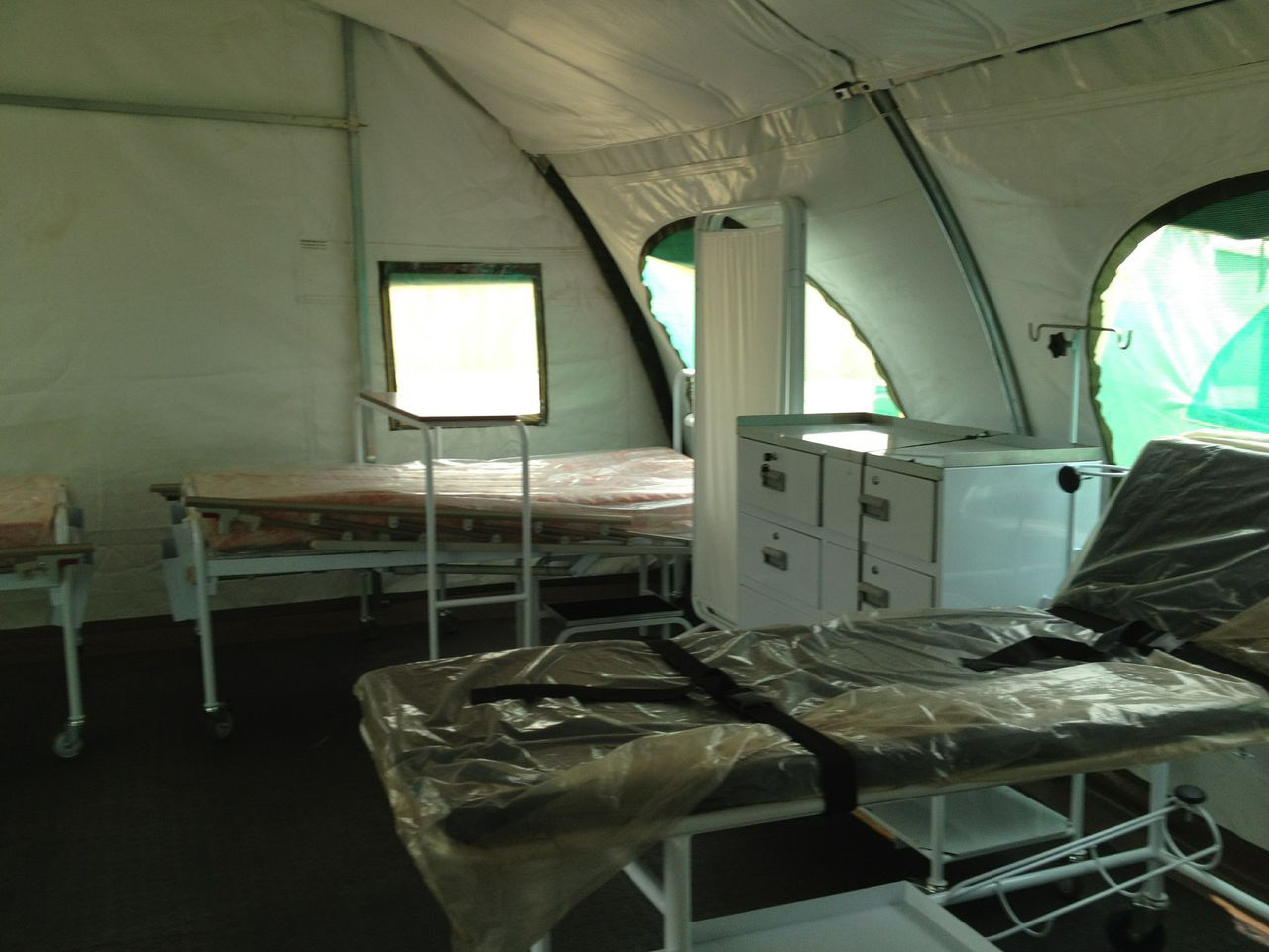
Although we had a fully functioning hospital, we heavily relied on the government ministries to supply us with relevant staff, so when the time came we could hand it over to them.
The initial emergency was a cholera outbreak, and reminded us that such a densely populated area creates a lot of new challenges. Incidents of malaria were on the increase, with two reported deaths in the first two weeks. Another large concern was there were several third trimester pregnancies in the camp.
We met with the Ministry of Health on several occasions, but very little help was offered. In the weeks that followed we did not receive any medication or staff. This resulted in a very expensive air-conditioned tent alongside a very large refugee camp. Treatment of patients was also delayed as we needed authorisation from the government.
Eventually, we received word we would be getting staff and ten days after completion they arrived, but to our dismay there was no doctor present. Although the nursing staff do have a lot of clinical knowledge and can practice independently, we needed a local doctor to help with referrals. We also needed the cooperation of the Ministry of Health to provide us with enough medication for the remainder of the time.
Our initial contract was for three weeks and a few days later we left Brazzaville and the hospital. I had a feeling of despair as we did not do much for the refugees in the time they needed us the most. Being hampered by bureaucracy, and officials not taking ownership of their responsibilities, was an eye-opening experience.

Return to Brazzaville
Three weeks later the foundation contacted me again and asked if I would be interested to return to Brazzaville, this time on a more permanent basis. My role would be to manage the hospital and to ensure that everything is in good working order. The Congolese ministry Délégation Générale des Grands Travaux (DGGT) have taken direct ownership and have requested a more permanent presence from the foundation.
On my arrival, I noticed that a lot had changed in the city. There were frequent protests against the government. The president had promised each household who lost a dwelling would receive 3 million Congolese Francs, the equivalent of $6 000 USD. This process, however, was very slow and the population were unhappy.
At the refugee camp things took a turn for the worse. Cholera and malaria were taking its toll and the general state of hygiene was atrocious. Toilets were dug and in place; however, few people seemed to use them. Although there was a large presence of foreign NGOs, the people needed a lot more.
The hospital was very busy. Word had spread that it was the only hospital supplying treatment and medication for free and this was attracting patients from far and wide. In my absence, a lady gave birth to twins and the midwives were very busy with expectant mothers. The laboratory was a bit of a let-down as half of the equipment could not be used and a lot of the chemicals were running low.
My initial task was to clean the place up. This was made difficult as the staff were reluctant to listen to an outsider. I found several sharps and contaminated dressings lying around in the treatment area. I had to educate each person and eventually my persistence paid off; I think the turning point was when I compared a loaded gun to a contaminated needle. Sharp containers were then properly being used and incinerated on site.
A very welcome face was that of the local doctor, Dr Emery. A paediatrician who had worked in Paris was the sole doctor available. We decided to work closely together through the future months to ensure that the hospital improved and that the level of improvement was maintained.
I was also now supplied with a jovial Congolese English teacher, Igor Mbongo. He turned out to be a blessing and ensured that a lot of my plans came to completion. My Western mentality and fast-paced lifestyle was put to the test early on as everything in Congo needs to be authorised, checked, double checked and then stamped several times before any action will be taken. Igor kept on reminding me that I have got to run on ‘Congo time’. In the months that followed, we had several stumbling blocks with the individual government departments. They were unconvinced that we could maintain a ‘free’ hospital. Help was often withheld and this made progress very difficult.
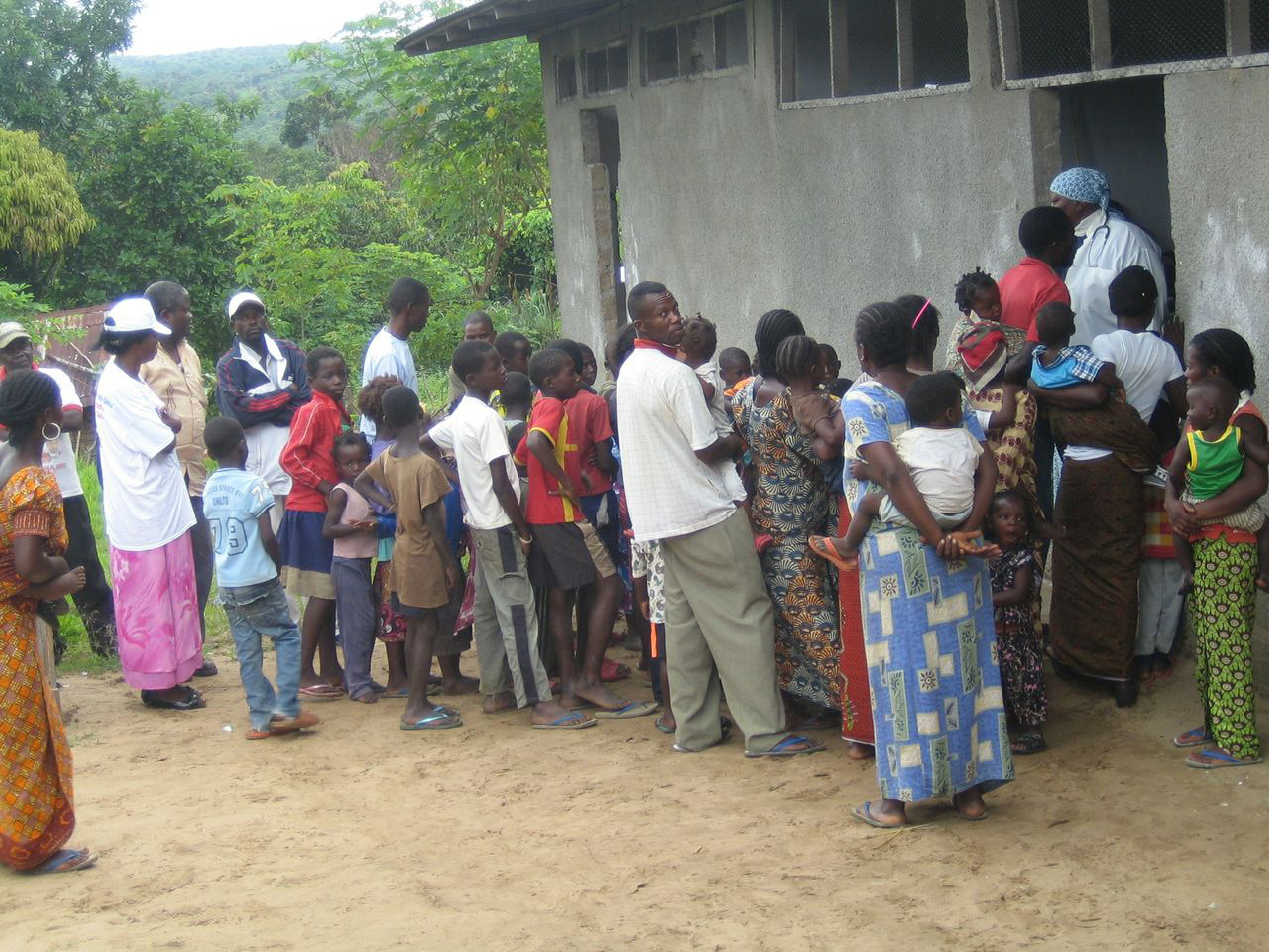
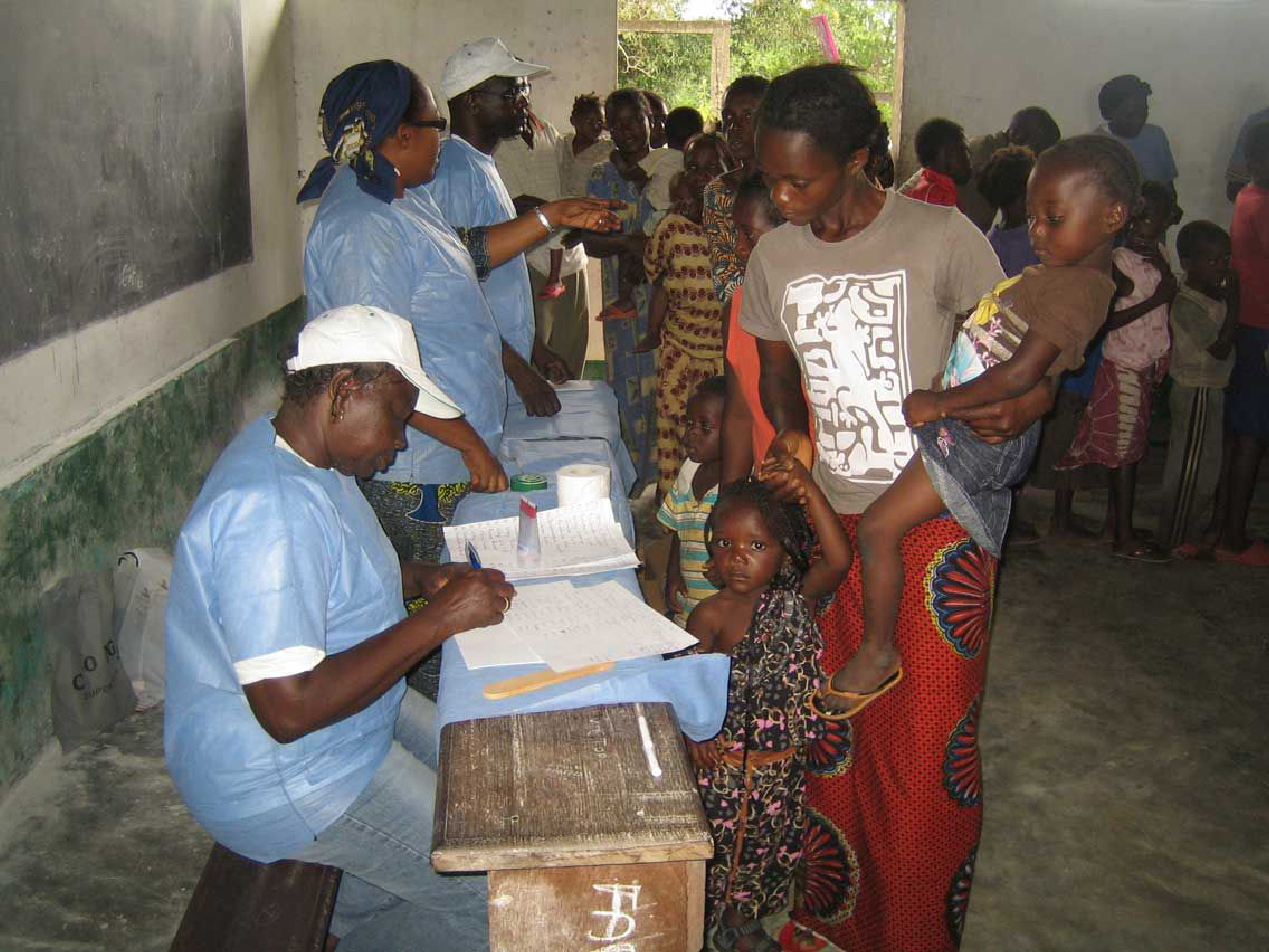
On my arrival, the hospital was only opened between 8 am and 3 pm. As most of the population living at the refugee camp were at work or school during those hours, we had to create a facility operating night and day. Initially this was met with scepticism, but after negotiating an incentive package they all accepted.
The supply of medication on a regular basis proved to be an uphill struggle. The pharmacists did not have any control over stock and let medication run out before applying for more. Some consumables and medication were being donated by other hospitals, which resulted in either inappropriate or out-of-date stock.
A huge problem was some of the staff were charging patients when nobody was looking. This was addressed by dismissal and a senior police officer threatening the culprits with criminal prosecution.
The facility was also in need of some urgent repairs. Air conditioners had been running non-stop for three months and the plumbing was blocked. I had to swap my stethoscope for a multi-tool and slowly tackled each problem. A maintenance programme was put in place, where local technicians would come and service the facility. Additional air conditioners were installed to cope with the daily onslaught of heat and sun. A borehole was sunk to provide the facility with clean water.

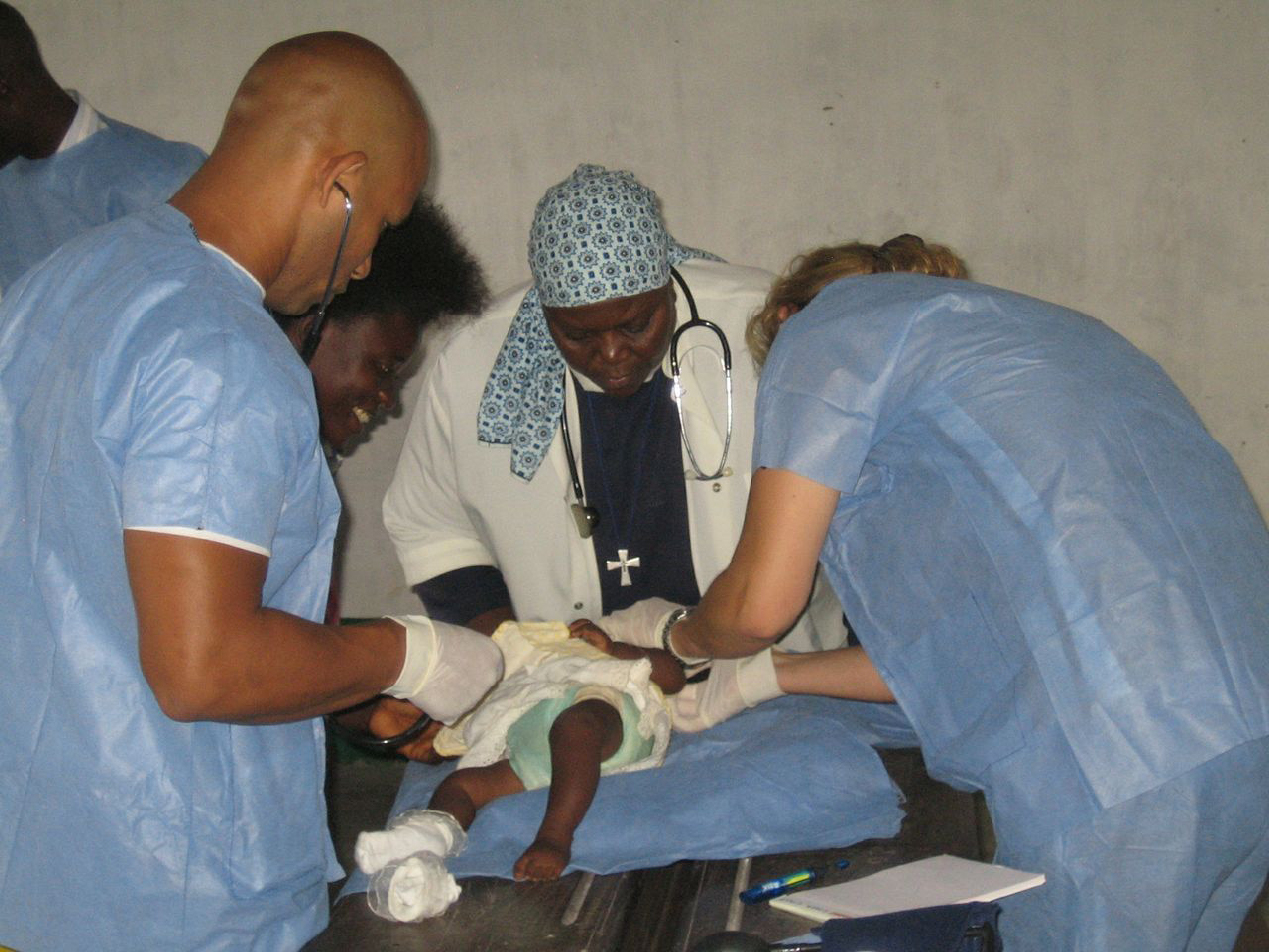
As word spread about the hospital we noticed a constant influx of patients. In the early days we were only treating 50 people, but within a few weeks the daily numbers rose to as high as 120. Malaria was the main ailment and the treatment rooms were filled with men, women and children on quinine IV drips. Some patients that were too ill to stay at the refugee camp were now staying overnight to ensure they were well rested prior to returning to their families next door.
I was working two weeks in Brazzaville then returning to Bristol, UK, for a week of rest. This was amazing for my air miles. Due to my increased workload I was joined by one of the initial crew that helped to construct the facility, Libby Heeger, an ILS paramedic from South Africa. We then rotated on a monthly basis.
Mid 2012 the refugee camp was disassembled. All the occupants had received their compensation and a promise their houses would be re-built. However, it had little impact on the amount of patients we were treating at the facility.
Our role was evolving from a clinical to a more managerial role. The staff at the clinic were also streamlined as some of the staff didn't approve of our operational schedule and regulations. The remaining staff were better motivated and slowly we noticed the hospital becoming more self-sufficient.
The area around the facility will eventually become the new hospital with additional staff quarters.
In 2013, I was introduced to a Congolese nun, Sister Bridgette, who runs an orphanage and polio rehabilitation centre near Maya-Maya airport. Educated in the USA, she had returned to the country of her birth to help the underprivileged. She established a polio centre to help the disabled, forming a cooperative where they build hand-powered tricycles. This was sold through networks, ensuring the manufacturers a constant income. Since then, she has also established craft workshops for the blind and deaf, and their products are sold in the markets.
Part of her mission is to provide medical care for the areas surrounding Brazzaville. With very little funds and relying on foreign aid, she travels to remote villages to treat up to 450 patients in one day. To assist with the venture she recruits volunteer doctors and nurses.
This provided us with the next challenge: expanding the clinic to provide care for the areas surrounding Brazzaville. It will certainly be a difficult process, but a worthwhile achievement once completed.

